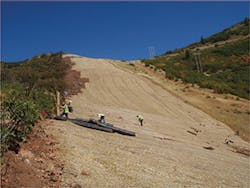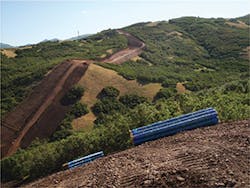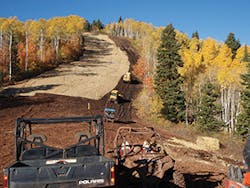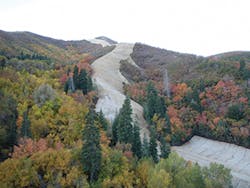Increasing miles of pipeline are being built to transport oil and natural gas across the US. More miles of pipeline equals a larger need for reclamation of those rights of way (ROWs) that have been affected by the excavation. Many companies entering the reclamation field or contracting such services have little experience, so there is a big need for education. Failure to establish vegetation or planting the wrong seed can lead to an unsuccessful reclamation, which turns into lost money and time. Lack of vegetation causes erosion, which can lead to a project not passing an inspection and, in the long term, to greater environmental damage. A failed project usually means more stringent measures have to be taken to stop erosion and turn the failure into a success. It’s better to have a good plan and excellent execution from the start.
Many of the experts interviewed for this article cited the same challenges that reclamation projects often face:
- Weather
- Terrain
- Inexperienced contractors handling the reclamation
- Need to educate landowners about the expected reclamation results
- Scheduling of crews and equipment, especially in difficult-to-access areas
The challenge of weather is lessened if the reclamation process can start in late spring. The seeds have a good chance to germinate, grow, and establish the vegetation needed for erosion control during spring and summer months. The work can proceed without days of inclement weather that slows the process and makes everything harder for the workers.
However, some projects must be accomplished in late fall or winter months. Changing seed or erosion control products can help in this time frame. Aaron DeJoia of Duraroot Environmental Consulting says that during the growing season, hydromulch that will last 6 to 12 months can be used at a cheaper cost. In the winter months, he recommends using a bonded fiber matrix, which will stabilize the soil for 12 to 18 months. The initial cost is higher, but the product will ensure the soil stays in place during the winter and provides good seed-to-soil contact once the growing season begins.
Seed choices must also be matched to the time of year. For late projects, a mix is needed to provide quick-growing vegetation. Other seed that will stay dormant through the winter can be included to provide long-term established vegetation in the next growing season.
Another challenge with weather is the occurrence of either drought or extra rain. If these conditions happen, changes might have to be made in the reclamation plan, or some mitigation might have to occur when the situation improves. Drought can prevent seed from germinating, and these pipeline reclamation projects are large enough that irrigation is out of the question. Too much rain causes more erosion problems and can also prevent establishment of vegetation.
Terrain can be a big impediment to any reclamation project. Steep slopes require more mitigation against erosion. Limited access requires more stringent scheduling for crews and equipment, and inaccessible areas may necessitate more equipment, such as helicopters and ATVs.
If reclamation efforts are included in the scope of work for pipeline installers, lack of knowledge can sometimes be an issue. Pipeline installers have their own expertise, but often it does not include understanding how to correctly prepare soil, apply seed and amendments, or install erosion control measures.
Education of landowners about pipeline construction can be a coordinated effort between the pipeline company and reclamation services. Landowners sometimes do not understand why their land cannot return to exactly the same condition as before the pipeline was placed. In wooded areas, owners often question why the ROW is not replanted with trees. They must understand the top-priority need to keep the pipeline intact after construction. Tree roots are notorious for causing leaks, which lead to a bigger environmental problem than the change in the look of the land. Reclamation companies also cannot replant the exact same species in every instance, and they should not be required to make changes in seed mixes in short increments, which would drastically increase the cost and the time to complete the project. Landowners need to know that the land will be cared for and will possibly be returned to a better condition than before. In many cases, the reclamation has led to increased habitat for wildlife and to stronger plant communities.
For many erosion control projects, soils are stabilized with permanent structures and vegetation work waits until construction is finished. For pipeline reclamation, crews for the revegetation effort must follow closely behind the construction crews. This can lead to complications for access to the site, availability of equipment and supplies, and issues when either the construction or reclamation crews face delays.
The reclamation plan should include species that will germinate and grow quickly and stabilize the soil. But plans must also provide long-term vegetation. Most states require an 80% vegetation cover at the one- or two-year mark to be deemed a successful reclamation.
Many possible complications must be anticipated before planning or implementing reclamation projects. These challenges can be seen in real life by looking at projects that have faced and overcome these issues.
Western Weather and Terrain
A project completed by Western States Reclamation Inc. (WSRI) of Frederick, CO, demonstrates the impact of both weather and terrain. WSRI contracted with Barnard Construction Company of Bozeman, MT, to handle the revegetation of a 28-mile pipeline. The pipeline runs from just outside Salt Lake City, UT, to Henefer, UT. It turned out to be one of the most complex reclamation efforts in the WSRI’s 30-year history.
The Apex Expansion pipeline runs through the Wasatch Mountains in northern Utah. The entire pipeline reaches from southwestern Wyoming to California. The 36-inch pipeline to be installed for this project is an expansion off of that original line. To fulfill a promise to union shops, WSRI created a union-based sister company, WSRII, to carry out the project.
The Wasatch Mountains are a semi-arid region, with about 16.5 inches of annual precipitation and 61 inches of snowfall. The project climbed to elevations of 8,677 feet, and the ROW width was between 100 and 150 feet. The total revegetation area was 390 acres, with 175 acres of erosion control blanket and 215 acres of seeding with straw mulch.
The plan called for site stabilization including backfilling, decompaction, recontouring, rock mulch, water bars, and revegetation. WSRII’s part of the effort was revegetation. The goal was to reestablish pre-construction contours and hydrology, minimize erosion and offsite sedimentation, reestablish vegetative communities as far as possible, and replace or enhance wildlife habitats. A three-year post-construction monitoring schedule would be in place.
The revegetation portion of the reclamation plan included seed bed preparation, seeding mixtures and rates, seeding methods, and reclamation treatments for steep slopes and erodible soils. The pipeline crossed three different vegetation communities—Great Basin sagebrush, mountain mahogany-oak scrub, and Douglas fir forest. The reclamation needed to accommodate these differing environments, so four seed mixes were specified.
The company knew that the terrain would be difficult. For slopes less than 30%, the strategy was soil preparation, drill seeding, straw mulch, and crimping. Slopes from 30 to 50% would be treated with hand-broadcast seed, hand raking, and erosion control blanket installation. Slopes greater than 50% would also have erosion control blankets installed, along with hand seeding and raking.
The initial plan called for 168 acres of revegetation and stabilization to be completed by late fall 2010 and the remaining acres to be finished by June of 2011. The plan was for a 24-person blanket crew and four-person tractor crew to keep up with the construction crew. Equipment, material, and crew would be transported with standard semis, four-wheel drive pickup trucks, and UTVs. Steeper areas were anticipated to slow the process.
The reclamation project began—and then everything changed. The culprit was the weather. Early and heavy snowfall in 2010 delayed the revegetation until June 2011. The planned 168 completed acres turned into 1.2 acres. Plan B had to go into effect.
The work had to be condensed, which meant bringing on larger crews and working on multiple stretches at a time. During this time, it was also determined that the original approach would not work because of site access limitations. Modifications were made, and work began again in the summer months.
One challenge presented itself almost immediately. Crews had to hike into areas inaccessible by vehicle. The heat and exhaustion from the extra activity did not lead to efficient, quality work. There were also difficulties with delivery of materials. Complications arose with scheduling use of dozers and helicopters that were shared with the pipeline contractor.
WSRII brought in its own helicopter company to complete straw drops and for crew transport to the hard-to-access areas. The company added school buses, dozers, and a dump truck to deliver crews and materials to the site. Project managers maintained a tight grip on the schedule. Field foremen were required to update labor, equipment, and material needs three times a day and communicate that information to the project managers.
With the modifications made, WSRII was able to complete the reclamation project five days ahead of schedule. The completion meant that the company avoided potential liquidated damages of $115,000 a day. Weather and terrain had been challenges, but the project was successful.
Lessons learned from this experience:
- Time spent validating access along a ROW is never wasted, especially in difficult terrain.
- A union project requires people who are experienced in that field.
- Critical management decisions must be made right away on a complex project.
- Staff should work through worst-case scenarios before the project starts so that decisions can be made quickly when needed.
Southwestern Project Faces Difficulties
A project stretching through southeastern New Mexico and west Texas illustrates one of the challenges for reclamation projects—inexperienced contractors. In 2015, Frontier Midstream Solutions LLC and Concho Resources Inc. began construction of the Alpha Crude Connector gathering system. The project would include gathering and transmission lines in Eddy and Lea counties in New Mexico and also in Loving, Winkler, and Culberson counties in Texas. It was the first large-scale gathering system in the northern Delaware Basin. The plan was to install 515 miles of pipeline and five market interconnects. The project took 18 months.
The reclamation portion of the project was divided into two areas—land controlled by the Bureau of Land Management and that of private landowners. The reclamation services were contracted under the scope of work of the subcontracted pipeline installers.
Bamert Seed Company, located in Muleshoe, TX, was contracted to provide seed. The company provided BLM-specified mixes per soil type for the public land. For private land, the mix was Bamert Seed Company’s Premium Pasture Blend incorporated with sterile triticale. This mixture would provide quick growth and establishment of the triticale along with long-term revegetation.
Rhett Kerby of Bamert says the biggest challenges with this project were that no reclamation specifications, other than seed, were provided in the contract, and the services were under the oversight of the subcontracted pipeline installers. He began to get phone calls from onsite inspectors who knew him from other projects. Because of the way the contract was written, he had provided insight for the correct seed mixes to be chosen, but he had no control over installation. No specifications were written into the contract for installation, and the pipeline installers had no experience in reclamation.
The onsite inspectors saw that the installers were using the correct seed, but they were applying it haphazardly, including tossing the seed out of the bed of a truck as they drove down the right of way. There was no preparation of soil or treatment of compaction if needed. “When seed is simply tossed on top of the ground, there is nothing to prevent it from blowing away or being eaten by birds,” notes Kerby. “Seed must have seed-to-soil contact.”
Kerby worked with the inspectors to help the installers to do a better application job. Finally, reclamation seeding companies were hired to plant the seed with the right equipment, ensuring good seed-to-soil contact and resulting in much better success in revegetation.
According to Kerby and many other experts interviewed for this article, the best advice for pipeline companies is to treat the reclamation process as a standalone contracted service. There are high failure rates, wasting money and time, when inexperienced pipeline contractors are handling tasks that are out of their expertise.
Right Product, Right Amounts
Aaron DeJoia says that on many projects, he sees contractors using the inappropriate product or the inappropriate amounts. No matter what soil amendment or erosion control product is being used, DeJoia recommends using the 4R principles: right time, right place, right rate, right source. He has consulted on projects in the northeastern US where lime was spread at blanket rates. Soil types and farming practices change frequently, and many areas do need lime as a soil amendment to mitigate acidity. By using the 4R principles, lime can be applied correctly based on soil properties, which often results in decreased cost and increased reclamation success.
The type of lime product used can also cause problems if rates are not calculated appropriately. Agricultural lime is the same material as most lime from soil amendment companies, just having a slower reaction time. Lime that is sold to be used as a hydromulch soil amendment is finer grain than ag lime. Because of this, contractors sometimes think that they can use significantly less of it. However, if not enough is used, the plants will green up quickly, but the vegetation doesn’t have staying power because the soil acidity was not adequately mitigated. The lime will initially lower the surface pH, but once the lime is consumed, the plants will begin to die off. Using the correct amount will ensure fast and continuous pH modification, resulting in better long-term reclamation success and erosion prevention.
The same logic goes for other amendments, such as fertilizer. The wrong application rate can cause a quick green-up that won’t last. Too much can damage vegetation and will waste money and time.
DeJoia also notes that planning for effective soil mapping and testing is the best start to any reclamation project. He recommends taking a close look at the terrain and soil maps, then making a plan for soil testing. For some sites and smaller projects, soil testing might need to be done three to four times per mile. On larger projects, testing every mile is usually sufficient as long as the soil scientist has enough data to interpolate across the unsampled areas. Soil can change within 100 feet. The terrain and soil maps will clue you in to possible soil changes. However, DeJoia adds that you have to be reasonable, not perfect: “You have to find a balance and think about what is constructable.” It’s wasteful and probably not feasible to have crews changing amendments or seed every 100 feet.
In general, soils in the eastern US are lower in pH and require amendments to mitigate that condition. In the western US, salinity is more of an issue. It must be tested for and the soil treated as needed. One size does not fit all, so soil testing is crucial.
Soil samples are only as good as how they are obtained, so make sure that the sampling is done throughout the ROW. Send samples to a qualified lab that will perform the testing and give you a correct interpretation. Then you can plan the amendments and materials required for the reclamation.
Understanding not only the soils but also the climate of an area is critical. Choosing seed mixes that can grow even in drought conditions is vital in the west. The definition of drought varies widely depending on what area is considered. A few weeks without rain can be considered a drought in much of the eastern US, while western states may not receive precipitation for months. Some areas can face weeks of rain or sudden, heavy downpours, so reclamation plans must be flexible to defeat those complications. Knowledge of the prevailing conditions and using that to choose the right seed and plan for stabilization is imperative.
Colorado Reclamation Company
H2 Enterprises based in Keenesburg, CO, was started by a farming family. They saw the need for reclamation after wildfires in the state, and the business has grown to include many kinds of reclamation projects. The company also sponsors the USA Reclamation Summit in April each year. At this conference, people working in the reclamation field gather to learn from experts, see equipment demonstrations, and interact with others to compare best practices.
Ryan Smith of H2 Enterprises shares what he sees as the biggest challenges for a successful pipeline reclamation project. One is not taking time to do effective soil studies. Using blanket specifications for seed and amendments does not work, he says, because even one ROW may have varying soil types. Huge differences can be seen among projects in different regions. So what works well in one place will often fail in another state.
H2 Enterprises starts with clearly mapping the land before construction so that it can be returned to a good natural state after construction. The company often uses drones to survey terrain and contours. By conducting thorough land studies and collecting enough soil samples, the reclamation plan can be accomplished without expensive failures.
Smith also stresses that safety is the top priority for crews in any terrain and on any project. Safety begins with training, even for people who have experience. In difficult terrain, training and attention to safety guidelines can make the difference for finishing the project with no injuries.
New Pipeline
Some of the projects above had complications that had to be faced after the fact. Many of these challenges could have been foreseen and prevented by a good plan pre-construction.
DeJoia is consulting on a large pipeline project in the northeastern US that has recently begun construction. The reclamation plan was carefully fabricated long before construction began. This early planning was crucial for the area, as the pipeline passes through some of the most productive agricultural land in the world.
The company building the pipeline took the time to build relationships with landowners and communities that would be affected by the construction. A local consultant was hired to help understand the community relationships and their connection to the soil. Members of the parent company met with local landowners, community leaders, and citizens to provide forums for questions and education about the construction and reclamation process. DeJoia was able to strengthen the understanding of team members about the importance of soil protection. He says that acknowledgment of the importance of protecting the soil, a unique and limited natural resource, went a long way to diminishing the concerns of the landowners. “I have worked and continue to work with the pipeline to design plans that protect the soil resource so that once completed, the farming community can continue to have productivity outputs that are equal to pre-construction conditions,” he says.
The plan has been fully laid out and communicated to the construction company. Contingencies are in place for unforeseen complications, so that problems are not allowed to slow down the construction and reclamation. The reclamation process is regarded as part of the construction, leading to a stronger team view and better coordination.
Reclamation Plan
There are many factors to consider in setting up a reclamation plan for a pipeline construction project. Make your plan based on the recommendations above. Then be ready to change the plan when conditions demand it.










